Search results for: 'Bronze a'
-
 Vespasian denarius from Wishanger hoard
Vespasian denarius from Wishanger hoardFound 2021 in East Hampshire, UK. The hoard is a very impressive proof of the fact that coins were in circulation for up to several centuries in the Roman era.
Price: on request Vespasian denarius from Wishanger hoard
Vespasian denarius from Wishanger hoardFound 2021 in East Hampshire, UK. The hoard is a very impressive proof of the fact that coins were in circulation for up to several centuries in the Roman era.
Price: on request Vespasian denarius from Wishanger hoard
Vespasian denarius from Wishanger hoardFound 2021 in East Hampshire, UK. The hoard is a very impressive proof of the fact that coins were in circulation for up to several centuries in the Roman era.
Price: on request Eight Roman bronze artifacts
Eight Roman bronze artifactsVarious artifacts in different states of preservation. Finds from the Roman city of Novaesium, today's Neuss in Germany.
Price: on request Marc Antony legionary Denarius from Wishanger hoard
Marc Antony legionary Denarius from Wishanger hoardFound 2021 in East Hampshire, UK. The hoard is a very impressive proof of the fact that coins were in circulation for up to several centuries in the Roman era.
Price: on request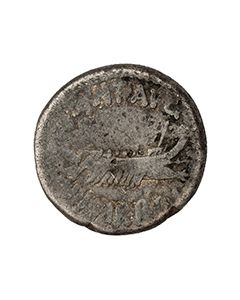 Marc Antony legionary Denarius from Wishanger hoard
Marc Antony legionary Denarius from Wishanger hoardFound 2021 in East Hampshire, UK. The hoard is a very impressive proof of the fact that coins were in circulation for up to several centuries in the Roman era.
Price: on request Marc Antony legionary Denarius from Wishanger hoard
Marc Antony legionary Denarius from Wishanger hoardLEG V or X. Found 2021 in East Hampshire, UK. The hoard is a very impressive proof of the fact that coins were in circulation for up to several centuries in the Roman era.
Price: on request Roman Republican denarius from Wishanger hoard
Roman Republican denarius from Wishanger hoardAnonymous, 2nd century BC. Found 2021 in East Hampshire, UK. Best condition of the five Marc Antony denarii in the hoard. The hoard is a very impressive proof of the fact that coins were in circulation for up to several centuries in the Roman era.
Price: on request Roman Republican denarius with galley from Wishanger hoard
Roman Republican denarius with galley from Wishanger hoardObverse showing janiform heads of the Dioscuri. Found 2021 in East Hampshire, UK. The hoard is a very impressive proof of the fact that coins were in circulation for up to several centuries in the Roman era.
Price: on request Roman Republican denarius of Renius from Wishanger hoard
Roman Republican denarius of Renius from Wishanger hoardBiga driven by goats on reverse. Found 2021 in East Hampshire, UK. The hoard is a very impressive proof of the fact that coins were in circulation for up to several centuries in the Roman era.
Price: on request Augustus denarius from Wishanger hoard
Augustus denarius from Wishanger hoardReverse showing Caius Caesar galloping right, eagle between two vexilla behind him. Found 2021 in East Hampshire, UK. The hoard is a very impressive proof of the fact that coins were in circulation for up to several centuries in the Roman era.
Price: on request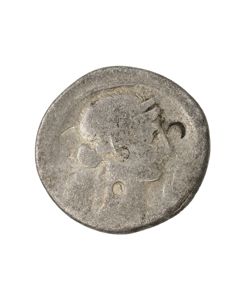 Octavian denarius from Wishanger hoard
Octavian denarius from Wishanger hoardShowing bust of Venus and Octavian in military dress. Found 2021 in East Hampshire, UK. The hoard is a very impressive proof of the fact that coins were in circulation for up to several centuries in the Roman era.
Price: on request Roman Republican L. Flaminius Cilo Denarius from Wishanger hoard
Roman Republican L. Flaminius Cilo Denarius from Wishanger hoardFound 2021 in East Hampshire, UK. The hoard is a very impressive proof of the fact that coins were in circulation for up to several centuries in the Roman era.
Price: on request Four Greek or Scythian arrow heads
Four Greek or Scythian arrow headsGroup of four bronze socketed arrowheads, mainly triangular cross-section. Excellent condition, beautiful patina. From an old German collection, acquired in the early 1980s.
Price: on request Four Greek or Scythian arrow heads
Four Greek or Scythian arrow headsGroup of four bronze socketed arrowheads, three with triangular cross-section and one leaf-shaped. Excellent condition, beautiful patina. From an old British collection, acquired before 1980.
Price: on request Four Greek or Scythian arrow heads
Four Greek or Scythian arrow headsGroup of four bronze socketed arrowheads, two with triangular cross-section and two leaf-shaped. Excellent condition, beautiful patina. From an old British collection, acquired before 1980.
Price: on request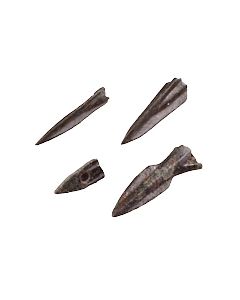 Four Greek or Scythian arrow heads
Four Greek or Scythian arrow headsGroup of four bronze socketed arrowheads, three with triangular cross-section and one leaf-shaped. Excellent condition, beautiful patina. From an old British collection, acquired before 1980.
Price: on request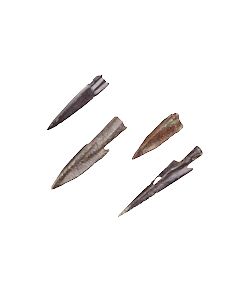 Four Greek or Scythian arrow heads
Four Greek or Scythian arrow headsGroup of four bronze socketed arrowheads, two with triangular cross-section and two leaf-shaped. Excellent condition, beautiful patina. From an old British collection, acquired before 1980.
Price: on request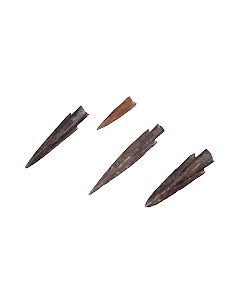 Four Greek or Scythian arrow heads
Four Greek or Scythian arrow headsGroup of four bronze socketed arrowheads with triangular cross-section. Excellent condition, beautiful patina. From an old British collection, acquired before 1980.
Price: on request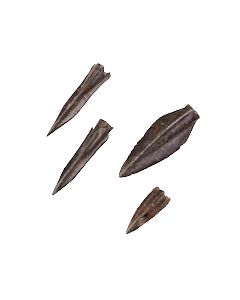 Four Greek or Scythian arrow heads
Four Greek or Scythian arrow headsGroup of four bronze socketed arrowheads, three with triangular cross-section and one leaf-shaped. Excellent condition, beautiful patina. From an old British collection, acquired before 1980.
Price: on request Four Greek or Scythian arrow heads
Four Greek or Scythian arrow headsGroup of four bronze socketed arrowheads with triangular cross-section. Excellent condition, beautiful patina. From an old British collection, acquired before 1980.
Price: on request Vespasian denarius from Wishanger hoard
Vespasian denarius from Wishanger hoardThe reverse shows the urn of Vespasian on a column. Great patina. Found 2021 in East Hampshire, UK. The hoard is a very impressive proof of the fact that coins were in circulation for up to several centuries in the Roman era.
Price: on request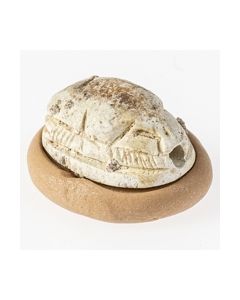 Canaanite scarab with pseudo hieroglyphs
Canaanite scarab with pseudo hieroglyphsThe scarab amulet was made during the Second Intermediate Period of Egypt or slightly later in Canaan. It has pseudo hieroglyphs on the bottom side.
Price: on request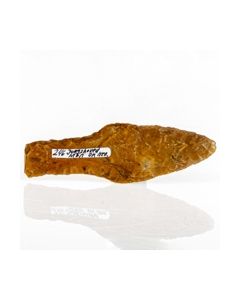 Scandinavian flint dagger
Scandinavian flint daggerNicely worked flint dagger from the transitional period between Late Neolithic and Early Bronze Age. Jungshoved on the Danish Island of Moen was the find spot.
Price: on request Phrygische Dreieckfibel aus Zentralanatolien
Phrygische Dreieckfibel aus ZentralanatolienAufwendig gestaltet, mit komplett erhaltener Nadel. Mitte 8. Jh. v. Chr. bis 7. Jh. v. Chr. Aus alter deutscher Privatsammlung.
Price: on request Eisenzeitliche Bronzefibel aus dem östlichen Mittelmeerraum
Eisenzeitliche Bronzefibel aus dem östlichen MittelmeerraumGroße und reich verzierte Fibel, ein früher eisenzeitlicher Typ. Die Oberseite ist mit einem komplexen Muster aus Linien und Voluten verziert. Nadel original erhalten und noch beweglich.
Price: on request Eisenzeitliche Bronzefibel aus dem östlichen Mittelmeerraum
Eisenzeitliche Bronzefibel aus dem östlichen MittelmeerraumReich verzierte Bronzefibel. Die Oberseite ist mit einem komplexen Muster aus Linien und Voluten verziert. Nadel original erhalten und noch beweglich.
Price: on request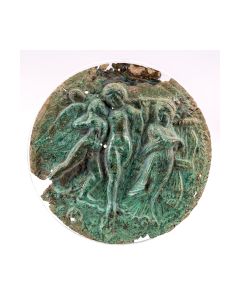 Published Etruscan mirror with Dionysian scene
Published Etruscan mirror with Dionysian sceneSubject of extended scientific analysis, one of only about 34 known specimen. High quality work, excellent condition. Described by Prof. Jucker as "small piece of art". From an old Swiss private collection. Overall in exceptional condition with thoroughly worked details.
Price: on request Sumerian foundation cone from Uruk
Sumerian foundation cone from UrukSmall conoid clay nail with cuneiform inscription. From the main temple of Uruk, that is also mentioned in the Epos of Gilgamesh. Circa 3rd Millenium BC.
Price: on request Early Etruscan sanguisuga fibula
Early Etruscan sanguisuga fibulaThe early Etruscan bronze brooch is characterized by its artistically decorated bow. From the collection of Professor Alder-Kissling.
Price: on request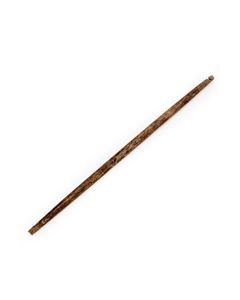 Egyptian spindle shaft made of wood
Egyptian spindle shaft made of woodExceptionally rare main piece of a hand spindle. A find from Thebes in Upper Egypt. From the reign of pharao Senusret II, around 1840 BC.
Price: on request Villanovan fibula from the Hattatt collection
Villanovan fibula from the Hattatt collectionBronze brooch of the Italic Iron Age. The piece is published in the standard work "Brooches of Antiquity".
Price: on request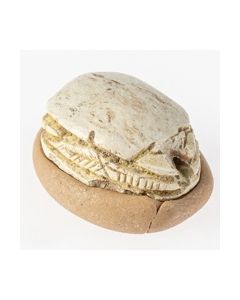 Canaanite scarab
Canaanite scarabLocal levantine production during the 13th to 15th dynasty of Egypt. With an export permit from the Israel Antiquities Authority.
Price: on request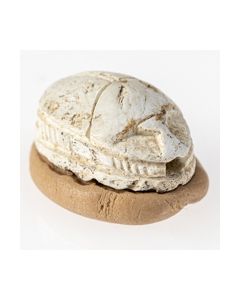 Canaanite scarab with pseudo hieroglyphs
Canaanite scarab with pseudo hieroglyphsThe scarab amulet was made during the Second Intermediate Period of Egypt or slightly later in Canaan. It has pseudo hieroglyphs on the bottom side.
Price: on request Large Villanovan fibula from the Hattatt collection
Large Villanovan fibula from the Hattatt collectionImposing bronze brooch of the Italic Iron Age. The piece is published in the standard work "Brooches of Antiquity".
Price: on request Brooch from Roman Britain
Brooch from Roman BritainThis rare variant of the T-shaped brooches was found in Lechlade, Gloucestershire. It dates to the 1st or 2nd century AR. From the famous Hattatt collection and published in two standard works for ancient fibulae.
Price: on request

